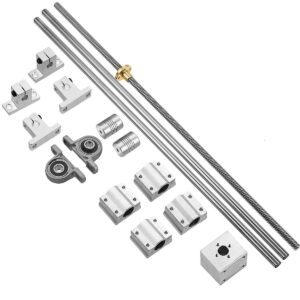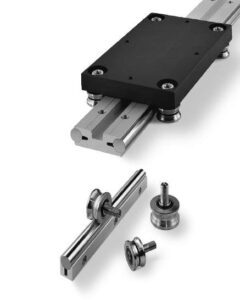In the world of high-precision engineering and automation, motion control is everything. Machines, robots, and tools rely on components that deliver smooth, stable, and accurate movement. At the heart of these systems lies the linear slide guide rail—a precision-engineered mechanical assembly that ensures frictionless linear motion and high repeatability.
Whether you’re looking at a CNC machining center, an industrial robot, or a 3D printer, linear slide guide rails form the backbone of reliable linear movement.
Introduction to Linear Slide Guide Rail
A linear slide guide rail is a motion component designed to provide precise, smooth, and low-friction movement in a straight line. It’s widely used in machinery that demands high precision, such as manufacturing automation, semiconductor production, and medical devices.
By converting rotary motion into linear displacement with the help of rolling elements, linear slide guide rails ensure that every move is exact—making them essential for any system requiring controlled and repeatable linear travel.
What is a Linear Slide Guide Rail?
A linear slide guide rail is a combination of a guide rail and a slide block (or carriage) that houses rolling elements like balls or rollers. The rail serves as a track, while the slide block moves smoothly along it. The contact between the rolling elements and the rail surface minimizes friction and wear, enabling long-term, stable performance even under heavy loads.
Unlike traditional plain slides that rely on sliding contact, linear slide guide rails use rolling contact, which ensures significantly higher accuracy and efficiency.
Working Principle of Linear Slide Guide Rail
The principle of operation revolves around rolling motion. The rail and slide block form a linear guideway system. Inside the block, rolling elements circulate in a closed path, continuously rolling between the block and rail surfaces.
This circulation eliminates stick-slip friction, maintaining a constant coefficient of friction even at high speeds. Some designs also incorporate preload mechanisms to enhance stiffness and reduce vibrations during operation.
Components of a Linear Slide Guide Rail System
The performance of a linear slide guide rail depends on the precision and interaction of its components. The main parts include:
Guide Rail: The hardened track that directs motion.
Slide Block (Carriage): The moving unit that supports and carries the load.
Rolling Elements: Balls or rollers that provide smooth motion.
End Caps: Ensure rolling elements recirculate properly.
Seals and Scrapers: Prevent dust and debris contamination.
Lubrication Ports: Enable grease or oil distribution for maintenance.
Each part plays a crucial role in maintaining the system’s high accuracy and smooth performance.
Types of Linear Slide Guide Rails
Linear slide guide rails come in different types, depending on the rolling element and structural design:
Ball Type Linear Slide Guide Rails
Roller Type Linear Slide Guide Rails
Cross Roller Type Linear Slide Guide Rails
Each type offers unique benefits suited to specific industrial applications.
Linear Ball Slide Guide Rails
Ball-type linear guide rails use spherical rolling elements. These provide smooth movement with minimal friction and are suitable for light to medium-load applications.
They’re commonly used in electronics assembly, medical instruments, and small CNC machines. Their key advantages include:
Compact design
High speed with low resistance
Excellent cost-performance ratio
However, they are less rigid than roller-type systems.
Linear Roller Slide Guide Rails
Roller-type linear slide guide rails employ cylindrical rollers as rolling elements, resulting in line contact with the rail surface instead of point contact. This design allows them to handle heavier loads and provide higher rigidity and precision.
They are widely used in machine tools, heavy automation systems, and high-precision industrial robots where vibration control and load capacity are critical.
Cross Roller Slide Guide Rails
In cross roller rails, rollers are arranged alternately at 90° angles to each other, forming an “X” pattern. This structure allows the guide rail to bear loads in all directions.
Commonly used in optical measurement systems, semiconductor fabrication, and ultra-precision instruments, they deliver exceptional smoothness and minimal backlash.
Design and Construction
Linear slide guide rails are designed for accuracy, rigidity, and stability. Both the rail and block are ground with micron-level precision. Rolling grooves are engineered to ensure even load distribution, and surfaces are hardened to resist wear.
The internal circulation path of rolling elements is carefully optimized to maintain uniform rolling resistance and low noise.
Materials Used in Linear Slide Guide Rails
| Material | Characteristics |
|---|---|
| High-Carbon Alloy Steel | High strength and rigidity |
| Stainless Steel | Corrosion resistance for clean environments |
| Aluminum Alloys | Lightweight for compact systems |
| Composite Materials | Reduced weight and vibration absorption |
For added protection, surface treatments like nickel plating, chrome coating, or black oxide are often applied.
Coatings and Surface Treatments
Protective coatings extend lifespan and improve resistance to harsh environments. Popular options include:
Nickel Coating: Corrosion and wear protection.
Black Oxide: Reduces reflection and adds mild corrosion resistance.
Chromium Plating: Provides a smooth, hard surface for minimal friction.
These coatings are vital for environments exposed to moisture, chemicals, or temperature changes.
Advantages of Linear Slide Guide Rails
Linear slide guide rails offer distinct advantages over traditional linear motion systems:
High Precision: Maintains accuracy even under dynamic loads.
Low Friction: Enhances efficiency and speed.
Excellent Rigidity: Ensures smooth operation under heavy loads.
Reduced Maintenance: Long life with minimal servicing.
Noise Reduction: Smooth rolling motion minimizes sound.
Long-Term Stability: Resistant to deformation and wear.
These benefits make them ideal for advanced automation systems.
Industrial Applications of Linear Slide Guide Rails
Linear slide guide rails are integral to a wide range of industries:
CNC machining centers and milling equipment
Industrial robotics and automation
Laser cutting and engraving systems
Semiconductor and electronics manufacturing
Medical imaging and diagnostic devices
3D printing and additive manufacturing
Their precision and reliability make them a standard choice for critical linear motion applications.
Linear Slide Guide Rails in CNC Machines
In CNC machines, accuracy is non-negotiable. Linear slide guide rails enable precise tool movement along defined axes, ensuring consistent cuts, smoother finishes, and repeatable operations.
High rigidity and minimal backlash help maintain stability, even during heavy machining tasks.
Linear Slide Guide Rails in Robotics
In robotics, linear slide guide rails allow for smooth, accurate movement in assembly lines, pick-and-place systems, and autonomous platforms. Their low-friction design reduces energy consumption while ensuring consistent positioning.
Installation of Linear Slide Guide Rails
For optimal performance, correct installation is critical:
Clean the mounting surface to remove dust and debris.
Align rails precisely using alignment jigs or measuring tools.
Tighten bolts uniformly with specified torque values.
Install lubrication fittings and apply initial grease.
Test for smooth motion along the full stroke length.
Misalignment can cause uneven wear, noise, and accuracy loss.
Maintenance and Lubrication
Regular maintenance ensures smooth operation:
Lubricate periodically using quality grease or oil.
Clean rails to remove dirt and metal particles.
Inspect for signs of wear or corrosion.
Replace seals when worn to maintain contamination protection.
Most systems now feature self-lubricating options that extend maintenance intervals significantly.
Troubleshooting Common Issues
| Problem | Possible Cause | Solution |
|---|---|---|
| Noise or vibration | Lack of lubrication | Reapply grease |
| Irregular motion | Misalignment | Realign rails |
| Increased friction | Contamination | Clean and reseal |
| Reduced accuracy | Rolling element wear | Replace guide block |
Quick inspection and correction prevent major failures and costly downtime.
Linear Slide Guide Rail vs Linear Bearings
| Aspect | Linear Slide Guide Rail | Linear Bearing |
|---|---|---|
| Load Capacity | High | Medium |
| Precision | Very High | Moderate |
| Friction | Extremely Low | Low |
| Maintenance | Low | Moderate |
| Lifespan | Long | Shorter |
| Application | CNC, robotics | Light automation |
Linear slide guide rails are best for heavy-duty and high-precision systems, while bearings suit lighter, cost-sensitive setups.
How to Select the Right Linear Slide Guide Rail
Consider these factors when choosing:
Load and Rigidity Requirements
Speed and Acceleration Needs
Operating Environment (dust, humidity, temperature)
Mounting Space
Maintenance Preferences
Consult manufacturer data sheets to match your design with optimal load ratings and motion tolerances.
Innovations in Linear Slide Guide Rails
The industry is rapidly evolving with:
Smart linear rails equipped with IoT sensors for condition monitoring.
Self-lubricating blocks eliminating manual maintenance.
Noise-optimized designs for quiet operation in cleanrooms.
Lightweight carbon composite rails for mobile and aerospace use.
These innovations improve performance, reduce downtime, and enhance sustainability.
Environmental and Sustainability Aspects
To support eco-friendly production, modern guide rails now include:
Recyclable materials in construction.
Biodegradable lubricants.
Energy-efficient manufacturing processes.
Extended-life coatings to minimize replacements.
Such advancements reduce waste and promote green automation solutions.
Cost and ROI Analysis
Although linear slide guide rails come at a higher initial cost, their low maintenance, high precision, and long lifespan ensure superior return on investment. Industries save on repairs, downtime, and calibration costs—making them a wise long-term choice for efficiency-driven operations.
Global Market Overview
The demand for linear motion systems is booming, fueled by automation, robotics, and smart manufacturing. Asia-Pacific leads production and innovation, with major manufacturers like THK, NSK, and HIWIN continuously pushing design limits to meet modern industrial challenges.

Future of Linear Slide Guide Rails
The future lies in intelligent, self-diagnosing guide rail systems that combine IoT and AI. These systems will monitor performance metrics like temperature, load, and vibration in real-time, predicting failures before they occur.
As industries move toward Industry 5.0, where humans and machines collaborate, linear slide guide rails will play a pivotal role in ensuring seamless, safe, and smart mechanical motion.
FAQs about Linear Slide Guide Rails
What is a linear slide guide rail used for?
It provides precise, low-friction linear movement in machines, robots, and automation systems.
How do I lubricate a linear slide guide rail?
Use manufacturer-approved grease or oil through the built-in lubrication port every few hundred operating hours.
Can linear slide guide rails handle vertical loads?
Yes, especially roller-type rails designed for multi-directional load support.
Do linear slide guide rails require frequent maintenance?
No, modern designs with self-lubrication require minimal servicing.
What is the difference between a ball and roller guide rail?
Ball rails are smoother and faster, while roller rails handle higher loads and provide greater rigidity.
How long do linear slide guide rails last?
With proper care, they can operate for millions of cycles—often exceeding ten years in industrial use.
Conclusion
The linear slide guide rail is more than a motion component—it’s a precision mechanism that drives the efficiency of modern industry. From CNC machines to robotic automation, its role in ensuring stability, accuracy, and reliability cannot be overstated.
As innovation continues, linear slide guide rails will evolve into smart, self-monitoring systems that define the next generation of precision motion engineering.
Suggested Inbound Links:
Linear Guideway Block: Structure and Benefits
Understanding Roller Rails in Automation
How to Maintain CNC Motion Systems



